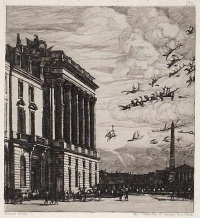Print room
From The Art and Popular Culture Encyclopedia
.jpg)

|
Related e |
|
Featured: |
A print room is a room in an art gallery, museum or archive, where a collection of old master and modern prints, usually together with drawings and watercolours, are held and viewed. What is by general consent the world's greatest collection overall is that of the Albertina (Vienna), currently completely closed for rebuilding. This is one of the relatively few print rooms to exist as a separate institution rather than as part of a larger museum or library; the Berlin Kupferstichkabinett at Kulturforum is another example.
Contents |
How to visit
Most national collections can be seen by the public more easily than is often realised. Usually, visitors of all sorts, whether researchers or not, are entitled to view works on paper not on display in the galleries, which will form the great majority of an institution's collection, thereby making print rooms an essential resource for enabling our understanding and appreciation of works on paper - in particular, how artists conceive of finished paintings through preparatory studies, and how printmaking traditions and techniques have evolved over the centuries. On a national level, print rooms tend to differ, each having their own specialism, however collections often overlap in content.
There are links to lists of print rooms at the end of the article; most lead to the gallery's or museum's web-pages, which explain visiting arrangements. In many cases appointments need to be made in advance, and proof of identity should usually be provided. While it is helpful to outline what you would like to see (including artists' names and catalogue numbers, which may be available online or in books), visitors are also usually welcome to discuss their needs more casually by phoning or emailing in advance of their appointment. It is important to remember that not all material will be available to view, depending on current loans and exhibitions commitments and the condition of works. Some especially fragile or valuable items may not normally be available for viewing.
Often not in the expected museum
Because of the need to keep them stored, prints and drawings are sometimes associated with library collections rather than collections of paintings. For example in Paris the main print (but not drawings) collection is in the Bibliotheque Nationale de France, not the Louvre. In New York and Washington, both the main art museums (Metropolitan Museum of Art and National Gallery of Art Washington) and the libraries (New York Public Library and Library of Congress)all have important, though very different, collections. Sometimes, material from non-Western traditions - in particular, Asian material, including Japanese prints - may or may not be held in the same department, or the same institution.
In London, the National Gallery holds no works on paper; only paintings and sculptures of the European tradition. The main collection of Western prints and drawings is held in the British Museum and includes fine examples by the Old Masters. Originally known as the national gallery of British art, Tate Britain holds British prints and drawings, which include the world's largest collection of watercolours, sketches and engravings by JMW Turner, historic works on paper from the late 18th and 19th centuries, and modern and contemporary British and International prints. The Victoria and Albert Museum's works on paper collection has a particularly broad remit, encompassing works of fine and applied art (including posters) as well as ephemera.
What is by general consent the world's greatest collection overall is that of the Albertina (Vienna), currently completely closed for rebuilding. This is one of the relatively few print rooms to exist as a separate institution rather than as part of a larger museum or library; the Berlin Kupferstichkabinett at Kulturforum is another example. The list of museums with major collections of European prints and drawings has some very incomplete figures on the holdings of major collections.
Collections
Deutschland
- Staatliche Museen zu Berlin, Kupferstichkabinett
- Kunstmuseum Bonn
- Herzog Anton Ulrich-Museum, Kupferstichkabinett, Braunschweig
- Kunsthalle Bremen, Kupferstichkabinett
- Kunstsammlungen der Veste Coburg, Kupferstichkabinett
- Hessisches Landesmuseum Darmstadt
- Kupferstich-Kabinett Staatliche Kunstsammlungen Dresden
- museum kunst palast, Düsseldorf
- Städelsches Kunstinstitut, Frankfurt am Main
- Hamburger Kunsthalle, Kupferstichkabinett
- Museum für Kunst und Gewerbe, Hamburg
- Staatliche Kunsthalle Karlsruhe, Kupferstichkabinett
- Staatliche Museen Kassel
- Wallraf-Richartz-Museum, Köln
- Museum der bildenden Künste Leipzig
- Staatliche Graphische Sammlung München
- Germanisches Nationalmuseum, Nürnberg
- Staatliches Museum Schwerin, Kupferstichkabinett
- Staatsgalerie Stuttgart
- Schlossmuseum, Weimar
Niederlande
- Rijksmuseum, Amsterdam
- Museum Boijmans van Beuningen, Rotterdam
- Teylers Museum, Haarlem
- Prentenkabinet, Universität Leiden
Österreich
- Alte Galerie, Kupferstichkabinett, Graz
- Akademie der bildenden Künste, Kupferstichkabinett, Wien
- Albertina, Wien
Schweiz
- Kunstmuseum Basel, Kupferstichkabinett
- Graphische Sammlung der Eidgenössischen Technischen Hochschule, Zürich
Verenigde Staten
- Chicago - Art Institute of Chicago
- Washington D.C. - National Gallery of Art, Department of Prints and Drawings
Nederland:
- Amsterdam - Rijksprentenkabinet van het Rijksmuseum Amsterdam
- Rotterdam - Prentenkabinet van Museum Boijmans Van Beuningen
- Leiden - Prentenkabinet van de Universiteitsbibliotheek Leiden
In België:
- Antwerpen - Museum Plantin-Moretus en het Stedelijk Prentenkabinet
- Brussel - Koninklijke Bibliotheek (België)
France
Literatuur
- Het Leidse Prentenkabinet. De geschiedenis van de verzamelingen, Baarn, De Prom (1994) ISBN 9068013998.
- Meesterwerken uit het Stedelijk Prentenkabinet van Antwerpen. Tekeningen uit de XVIde en XVIIde eeuw, Antwerpen (1988).
- Honderd tekeningen van oude meesters uit het Prentenkabinet van Dresden, Brussel (1967).
_-_Hendrick_Goltzius.jpg)


